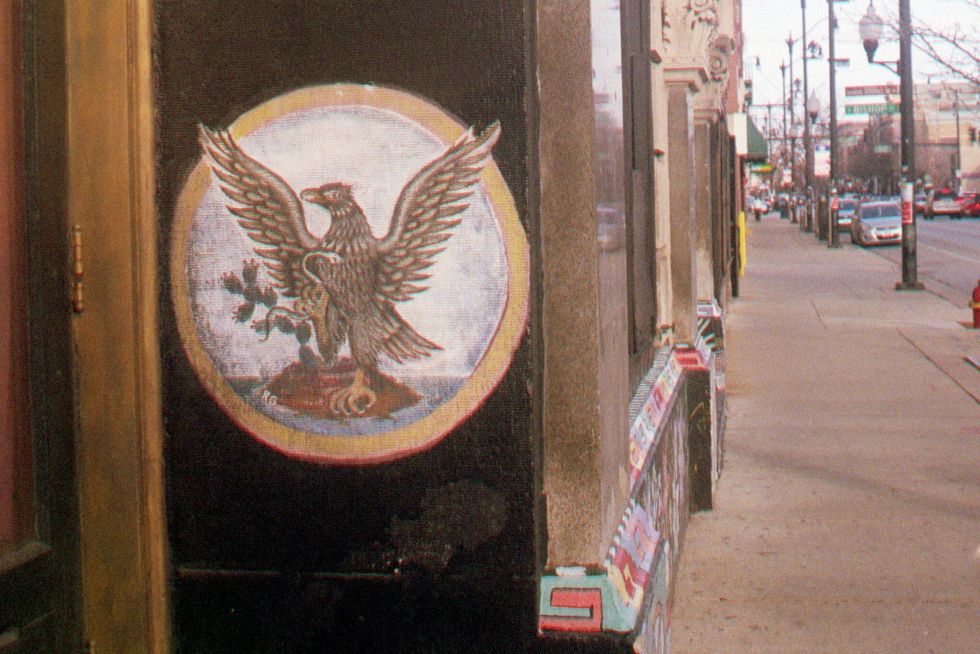First, some context: I work at the public library in Pilsen, a primarily Mexican-American neighborhood on Chicago’s Lower West Side. The neighborhood high school, Benito Juarez Academy, proudly flies American, Chicago, and Mexican flags. Pilsen is known throughout Chicago for its many murals celebrating Latin American culture. Under threat from gentrification and the current political situation, Pilsen continues to take pride in its heritage, as I was reminded the Friday before last.
As I waited at the corner of 18th and Loomis at 8 p.m., crossing my arms against the too-cold-for-April weather, a man in a CTA jacket taped a sign to the bus stop: a reroute for the next day. Which meant I couldn’t take my usual bus to work—great.
The next day was Good Friday, which I had forgotten, even though I was going straight from work to Union Station to visit my family for Easter. When I got to work, my coworker Elvira told me the buses were rerouted because of the Via Crucis, a massive stations-of-the-cross procession that marches for a mile and a half down 18th, the main street in Pilsen. “You can see it out the window,” she said. “If you haven’t seen it before you should definitely watch it.” My other Latino/a coworkers discussed watching it on TV in years past. This is a huge, televised event that’s been going on for forty years, I thought. How have I never heard of it?
At 11:00, our security guard, Rafael, stepped outside then came back in and announced, “They’re coming!” Outside, I was greeted by sunshine (in contrast to that morning’s clouds) and crowds lining the street. Farther down the street, I could see the procession heading our way and hear Spanish-language hymns playing from a large speaker on top of a van. Looking around, I recognized the faces of regular patrons amongst the crowd.
After a few minutes, I ran back inside and checked if Elvira wanted to come out for a bit, saying I could cover inside. “Oh no, I can watch from in here!” she replied. “You’ve never seen it!” As I walked back out I was joined by our clerk, who was subbing that day and came from a different branch. It was, I believe, her first time in Pilsen.
A few drummers led the procession, followed by a crowd of people dressed in everyday clothes. I assumed they were all coming from the preceding mass, but Rafael clarified that, in addition, after each stop in the route, the onlookers join. By the time the procession ends in Harrison Park, it numbers in the thousands. Then came a girl dressed as an angel and a number of Roman soldiers, and then the main event, a man dressed as a bloodied Jesus, carrying a cross. Behind him a soldier carried a handwritten sign reading “Jesús de Nazaret, Rey de los Judios.”
In front of the library, the procession stopped. Suddenly, the whole crowd began speaking in unison. I wondered how they knew what to say, since no one in the procession seemed to be leading them, until I realized they were all reciting the Lord’s Prayer in Spanish. After that came, even louder: “Santa Maria, madre de Dios...” It’s rare to find silence in the city, but at that moment, the streets of Pilsen were quiet save for those Spanish words. The individual prayers were not particularly loud; they were only audible because of the cumulative effect of thousands of people reciting them at once.
I’m from a Christian family, and while I now consider myself agnostic, I appreciate the role of religion in other people’s lives. I love observing and learning about religious practices, especially when that religion is interwoven with a broader cultural heritage. This is why, after my Jewish roommate hosted a Passover seder at our apartment last year, I wholeheartedly agreed to doing another this year. I loved learning what each item on the seder plate represented and loudly singing “day-day-dayenu!”
As I stood amidst the crowd, hearing thousands spontaneously begin to pray in what for many is their native language, I felt overcome with emotion. I’ve been to a Passion Play before, numerous times, at a Seventh-Day Adventist university near my hometown. But while it was moving, it didn’t feel quite the same as the Via Crucis. This was not just the collective effervescence I often feel in religious settings or other large groups. (Collective effervescence is a term coined by sociologist Emile Durkheim; in short, it’s the ecstatic feeling of being a part of something bigger than yourself when in a group. Durkheim believed this was at the root of religious ceremonies.) It was also the feeling of tradition, of community pride.
Soon after, the procession began moving again. The onlookers moved from the sidewalk into the street to continue the march west. My coworkers and I returned inside, to the library with its Olmec-influenced adornment and artwork by Hispanic artists. “How was it?” Elvira asked me.
I didn’t know how to explain what I was feeling—the lifted spirits, the love for this neighborhood I ended up working in by chance, the love for this beautiful multicultural city I now call home. So I simply replied, “It was wonderful.”



 Photo by
Photo by  Photo by
Photo by  Photo by
Photo by 



















